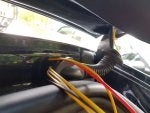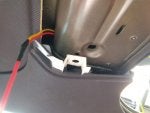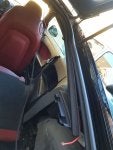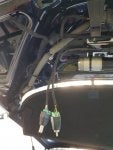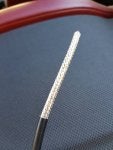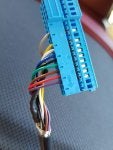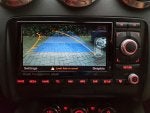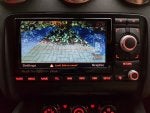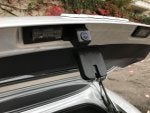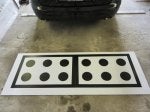Following from my previous retrofit of front and rear parking sensors with OPS I have now got the full R8 system functioning, which includes a reversing camera with moving guidelines as well as reverse parking and parallel parking modes.
Initial test fit with messy wires resulting in poor image quality, but a good enough indicator to continue:
Parts
8V0 827 566 - Camera (from Audi A3 8V)
4G5 827 229 - Camera bracket
6mm SBR rubber sheet
M6 sleeve nut x2
M10 4mm heavy washer x2
M10 spring washer x2
1J0 973 119 - 2 pin connector for camera power
000 979 019 E - Pins (micro timer) x2
Female FAKRA Z to female RCA adaptor
1J0 973 119 - 2 pin connector for boot button
000 979 019 E - Pins (micro timer) x2
000 979 009 E - Pin for central convenience module
420 910 441 A - Camera module supporting OPS (from Audi R8 42)
4E0 972 144 - 54-pin connector
TE 2-1411550-1 - Pins (ELO) x15
Female right angle FAKRA Z to female RCA adaptor
EVA high density foam to secure the module
N 907 327 03 - Pin for fuse (Standard Power Timer)
000 979 009 E - Pins for RNSE 32 pin connector (MQS) x6
Male RCA connector
Wire 0.35mm2
Wire 8 core 0.22mm2 screened stranded
Fitting
The feeding of wires is covered in other places, including this comprehensive post, so I'll skim over that here.
Firstly, there is no 'official' mounting location for the camera module, so I chose to position it behind the right boot trim near the parking sensor module. Wires need to be be run in two directions, (1) to the RNSE and (2) to the camera in the tailgate.
![8.jpg 8.jpg]()
(1)
I have documented how I fed my parking sensor wires through the car in the past, see this guide for some photos https://www.ttforum.co.uk/forum/viewtop ... &t=1837385
I used 8 core 0.22mm2 screened stranded cable for the video feed:
![4.jpg 4.jpg]()
The connector wired up (with outer housing removed):
![5.jpg 5.jpg]()
I used screw terminal RCA connectors, with Fakra adaptors on both ends.
The module fitted in the spare space near the convenience/PDC modules. I used some EVA high density foam on the left to hold it firmly in place:
![20200411_124033.jpg 20200411_124033.jpg]()
(2)
Feeding the wires to the camera is a pain but not too bad. With the tailgate trim and boot trim removed, use a thick wire to help feed the wires up the C pillar, through the right grommet, down the rear screen and eventually to where the number plate lights are mounted.
![1.jpg 1.jpg]()
![2.jpg 2.jpg]()
![3.jpg 3.jpg]()
In order to mount my camera, I needed to cut a rectangular opening in the tailgate. A daunting prospect but it gives a neat OEM finish.
![6.jpg 6.jpg]()
Due to the tailgate lip, it needs to be spaced out slightly. I used 6mm thick SBR rubber sheet to make a gasket for the camera:
![20200624_183816.jpg 20200624_183816.jpg]()
Because of the gasket, the standard nuts will no longer reach the thread, so I used spacers, spring washers and sleeve nuts:
![20200530_192721.jpg 20200530_192721.jpg]()
The result is a good clear image without too much obstruction:
![20200531_155246.jpg 20200531_155246.jpg]()
![20200605_104314.jpg 20200605_104314.jpg]()
Wiring
Reversing camera system control unit (J772) - (54-pin connector, black)
Pin 25 > RNSE (T32b), pin 14 (screen earth)
Pin 27 > RNSE (T32b), pin 15 (video output sync)
Pin 28 > RNSE (T32b), pin 30 (video output sync earth) (splice all RGBS earths together)
Pin 29 > RNSE (T32b), pin 31 (video output blue)
Pin 30 > RNSE (T32b), pin 30 (video output blue earth) (splice all RGBS earths together)
Pin 31 > RNSE (T32b), pin 16 (video output green)
Pin 32 > RNSE (T32b), pin 30 (video output green earth) (splice all RGBS earths together)
Pin 33 > RNSE (T32b), pin 32 (video output red)
Pin 34 > RNSE (T32b), pin 30 (video output red earth) (splice all RGBS earths together)
Pin 39 > Infotainment CAN low (splice Bose amp T32a pin 32 - orange/brown)
Pin 40 > Infotainment CAN high (splice Bose amp T32a pin 27 - orange/purple)
Pin 43 > Fuse 5 in boot fuse box (5A) (positive, permanent live)
Pin 44 > Terminal 31 (earth)
Pin 47 > Camera power connector, pin 2 (earth)
Pin 48 > Camera power connector, pin 1 (positive)
FAKRA ground > Camera phono (ground) (black)
FAKRA signal > Camera phono (signal) (yellow)
![Camera module.png Camera module.png]()
Camera power connector - (2-pin connector, black)
Pin 1 > Reversing camera system control unit, pin 48 (positive)
Pin 2 > Reversing camera system control unit, pin 47 (earth)
Rear lid handle release button
The boot handle is also functional, which is a bonus, due to modules being shared with the A3.
Pin 1 >
Coding
19-CAN Gateway - Installation List
10-Park/Steer Assist - Coding
37-Navigation
6C-Back-up Cam.
Calibration
< WORK IN PROGRESS >
Initial test fit with messy wires resulting in poor image quality, but a good enough indicator to continue:
Parts
8V0 827 566 - Camera (from Audi A3 8V)
4G5 827 229 - Camera bracket
6mm SBR rubber sheet
M6 sleeve nut x2
M10 4mm heavy washer x2
M10 spring washer x2
1J0 973 119 - 2 pin connector for camera power
000 979 019 E - Pins (micro timer) x2
Female FAKRA Z to female RCA adaptor
1J0 973 119 - 2 pin connector for boot button
000 979 019 E - Pins (micro timer) x2
000 979 009 E - Pin for central convenience module
420 910 441 A - Camera module supporting OPS (from Audi R8 42)
4E0 972 144 - 54-pin connector
TE 2-1411550-1 - Pins (ELO) x15
Female right angle FAKRA Z to female RCA adaptor
EVA high density foam to secure the module
N 907 327 03 - Pin for fuse (Standard Power Timer)
000 979 009 E - Pins for RNSE 32 pin connector (MQS) x6
Male RCA connector
Wire 0.35mm2
Wire 8 core 0.22mm2 screened stranded
Fitting
The feeding of wires is covered in other places, including this comprehensive post, so I'll skim over that here.
Firstly, there is no 'official' mounting location for the camera module, so I chose to position it behind the right boot trim near the parking sensor module. Wires need to be be run in two directions, (1) to the RNSE and (2) to the camera in the tailgate.
(1)
I have documented how I fed my parking sensor wires through the car in the past, see this guide for some photos https://www.ttforum.co.uk/forum/viewtop ... &t=1837385
I used 8 core 0.22mm2 screened stranded cable for the video feed:
The connector wired up (with outer housing removed):
I used screw terminal RCA connectors, with Fakra adaptors on both ends.
The module fitted in the spare space near the convenience/PDC modules. I used some EVA high density foam on the left to hold it firmly in place:
(2)
Feeding the wires to the camera is a pain but not too bad. With the tailgate trim and boot trim removed, use a thick wire to help feed the wires up the C pillar, through the right grommet, down the rear screen and eventually to where the number plate lights are mounted.
In order to mount my camera, I needed to cut a rectangular opening in the tailgate. A daunting prospect but it gives a neat OEM finish.
Due to the tailgate lip, it needs to be spaced out slightly. I used 6mm thick SBR rubber sheet to make a gasket for the camera:
Because of the gasket, the standard nuts will no longer reach the thread, so I used spacers, spring washers and sleeve nuts:
The result is a good clear image without too much obstruction:
Wiring
Reversing camera system control unit (J772) - (54-pin connector, black)
Pin 25 > RNSE (T32b), pin 14 (screen earth)
Pin 27 > RNSE (T32b), pin 15 (video output sync)
Pin 28 > RNSE (T32b), pin 30 (video output sync earth) (splice all RGBS earths together)
Pin 29 > RNSE (T32b), pin 31 (video output blue)
Pin 30 > RNSE (T32b), pin 30 (video output blue earth) (splice all RGBS earths together)
Pin 31 > RNSE (T32b), pin 16 (video output green)
Pin 32 > RNSE (T32b), pin 30 (video output green earth) (splice all RGBS earths together)
Pin 33 > RNSE (T32b), pin 32 (video output red)
Pin 34 > RNSE (T32b), pin 30 (video output red earth) (splice all RGBS earths together)
Pin 39 > Infotainment CAN low (splice Bose amp T32a pin 32 - orange/brown)
Pin 40 > Infotainment CAN high (splice Bose amp T32a pin 27 - orange/purple)
Pin 43 > Fuse 5 in boot fuse box (5A) (positive, permanent live)
Pin 44 > Terminal 31 (earth)
Pin 47 > Camera power connector, pin 2 (earth)
Pin 48 > Camera power connector, pin 1 (positive)
FAKRA ground > Camera phono (ground) (black)
FAKRA signal > Camera phono (signal) (yellow)
Camera power connector - (2-pin connector, black)
Pin 1 > Reversing camera system control unit, pin 48 (positive)
Pin 2 > Reversing camera system control unit, pin 47 (earth)
Rear lid handle release button
The boot handle is also functional, which is a bonus, due to modules being shared with the A3.
Pin 1 >
- Pre ~2009 cars with J393 central convenience module > T8g, pin 6
- Post ~2009 cars with convenience module combined with J519 central electric (BCM) > T52a, pin 13
Coding
19-CAN Gateway - Installation List
- Enable '6C - Back-up Cam.'[/*]
10-Park/Steer Assist - Coding
- Byte 0, bit 5 - enable 'Rear View Camera installed'[/*]
37-Navigation
- Adaptation:
- Channel 04: Rear View Camera
- 3 = Rear View Camera (BAP/RNS-E PU) installed[/*]
- [/*]
- Channel 04: Rear View Camera
- [/*]
6C-Back-up Cam.
- Coding:
- ?xx0xxx: Manufacturer
- 1 = Audi[/*]
- [/*]
- x?x0xxx: Market
- 0 = Rest of World (RoW)[/*]
- [/*]
- xx?0xxx: Trailer & Parking System
- +2 = Optical Parking System installed[/*]
- [/*]
- xxx0?xx: Camera Height
- 7 = Camera Height 8 (+70 mm)[/*]
- [/*]
- xxx0x??: Model
- 12 = Audi R8 (42) with Standard Camera Height 665 mm[/*]
- [/*]
- ?xx0xxx: Manufacturer
- [/*]
Calibration
< WORK IN PROGRESS >


